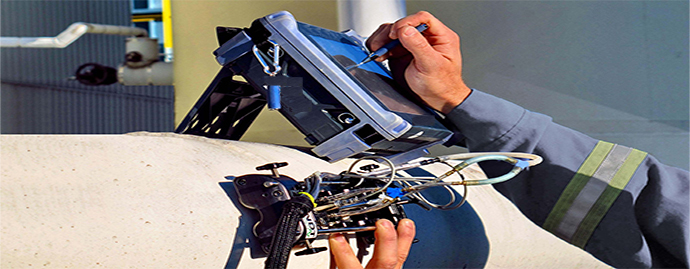| تاريخ البداية | تاريخ النهاية | الدولة | المدينة |
|---|

 +۹٦٦ ۹۲۰۰۰۷۷۷۱
+۹٦٦ ۹۲۰۰۰۷۷۷۱

الأهداف
- The objective of the course is to present an overview of Acoustic Testing, identifying the advantages and limitations of this as compared to other methods of Non-destructive Testing.
الخطوط العريضة
Level II - Outline
I. Principles of AE Testing
a. Characteristics of AE Testing
i. Introductory concepts of source, propagation, measurement, display,
evaluation
ii. Relationships between AE and other NDT methods
iii. Significance of applied load in AE testing
iv. Basic Math review
b. Materials and Deformation
i. Constitution of crystalline and noncrystalline materials
ii. Stress and strain
iii. Elastic and plastic deformation; Crack growth
c. Sources of AE
i. Burst emission, Continuous emission
ii. Emission signals/levels, units of amplitude measurement
iii. Sources in crystalline materials
1. Dislocations – plastic deformation
2. Phase transformations
3. Deformation twinning
4. Nonmetallic inclusions
5. Subcritical crack growth
a. Subcritical crack growth under increasing load
b. Ductile tearing under increasing load
c. Fatigue crack initiation and growth
d. Hydrogen embrittlement and cracking
e. Stress corrosion and cracking
iv. Sources in nonmetals
1. Microcracking
2. Gross cracking
3. Crazing
4. Other sources in nonmetals
v. Sources in composites
1. Fiber breakage
2. Matrix cracking
3. Fiber-matrix debonding
4. Delamination
5. Fiber pull-out, relaxation
6. Friction
vi. Other sources
1. Pressure leaks
2. Oxide and scale cracking
3. Slag cracking
4. Frictional sources
5. Liquefaction and solidification
© 2009 WavesinSolids LLC
6. Loose parts, intermittent contact
7. Fluids, and nonsolids
8. Crack closure
d. Wave Propagation
i. Near-field impulse response
ii. Modes of propagation
iii. Mode conversion, reflection and refraction
iv. Wave velocity in material
v. Anisotropic propagation in composites
vi. Specimen geometry effects
e. Attenuation
i. Geometric attenuation
ii. Dispersion
iii. Scattering, diffraction
iv. Attenuation due to energy loss mechanisms
v. Attenuation vs. frequency
f. Kaiser and Felicity Effects, and Felicity Ratio
i. In metals
ii. In composites
iii. In other materials
g. Terminology (ASTM E1316)
II. Sensing the AE Wave
a. Transducing processes (piezoelectricity, etc.)
b. Sensors
i. Construction
ii. Conversion efficiencies
iii. Calibration (Sensitivity curve)
c. Sensor attachment
i. Coupling materials
ii. Attachment devices
iii. Waveguides
d. Sensor utilization
i. Flat response sensors
ii. Resonant response sensors
iii. Integral-electronics sensors
iv. Special sensors (directional, mode responsive)
v. Sensor selection
III. Instrumentation and Signal Processing
a. Cables
i. Coaxial cable
ii. Twisted pair cable
iii. Noise problems in cables
iv. Impedance matching
v. Connectors
b. Signal conditioning
© 2009 WavesinSolids LLC
i. Preamplifiers
ii. Amplifiers
iii. Filters
iv. Units of gain measurement
c. Signal detection
i. Threshold comparator
ii. Units of threshold measurement
iii. Sensitivity determined by gain and/or threshold
d. Signal processing
i. Waveform characteristics
1. Amplitude analysis
2. Pulse duration analysis
3. Rise time analysis
4. Event and event rate processing
5. MARSE
ii. Discrimination techniques
iii. Distribution techniques
e. Source location techniques
i. Single channel location
ii. Linear location
iii. Planar location
iv. Other location techniques
f. AE test systems
i. Single channel systems
ii. Multi-channel systems
iii. Dedicated industrial systems
g. Accessory techniques
i. Audi indicators
ii. X-Y and strip chart recording
iii. Oscilloscopes
iv. Magnetic recorders
v. Others
h. Advanced signal processing techniques
i. Signal definition
ii. Signal capture
iii. Frequency analysis
iv. Pattern recognition
IV. AE Test Techniques
a. Factors affecting testing equipment selection
i. Material being monitored
ii. Location and nature of emission
iii. Type of information desired
iv. Size and shape of test part
b. Equipment calibration and setup for test
i. Calibration signal generation techniques
ii. Calibration procedures
iii. Sensor placement
iv. Adjustment of equipment controls
v. Discrimination technique adjustments
c. Loading procedures
© 2009 WavesinSolids LLC
i. Type of loading
ii. Maximum test load
iii. Load holds
iv. Repeated and programmed loadings
v. Rate of loading
d. Special test procedures
i. High temperature/low temperature tests
ii. Interrupted tests (including cyclic fatigue)
iii. Long term tests
iv. Tests in high noise environments
e. Data display
i. Selection of display mode
ii. Use and reading of different kinds of display
f. Noise sources and pre-test identification techniques
i. EM noise
ii. Mechanical noise
g. Precautions against noise
i. Electrical shielding
ii. Electronic techniques
iii. Prevention of movement
iv. Attenuating materials and applications
h. Data interpretation
i. Recognizing noise in the recorded data
ii. Noise elimination by data filtering techniques
iii. Relevant and nonrelevant AE response
i. Data Evaluation
i. Methods for ranking, grading, accepting/rejecting
ii. Comparison with calibration signals
iii. Source evaluation by complementary NDT methods
j. Reports
i. Purpose
ii. Content and structure
iii.
V. Codes, Standards, Procedures and Societies
i. Guide-type standards (glossaries, calibration, etc)
ii. Standardized/codified AE test procedures
iii. User-developed test procedures
iv. Societies active in AE
VI. Applications of AE Testing
a. Laboratory Studies (Material Characterization) – At least 3 categories
i. Crack growth and fracture mechanics
ii. Environmentally assisted cracking
iii. Dislocation movement (metals)
iv. Clarifying deformation mechanisms (composites)
v. Phase transformations and phase stability
vi. Creep
vii. Residual stress
viii. Corrosion
ix. Fatigue
x. Rupture
© 2009 WavesinSolids LLC
xi. Ductile/brittle transition
xii. Other material characterization applications
b. Structural Applications – At least 4 categories
i. Pressure vessels (metal)
ii. Storage tanks (metal)
iii. Composite pressure vessels/storage tanks
iv. Piping and pipelines
v. Bucket trucks
vi. Aircraft
vii. Bridges
viii. Mines
ix. Dams, earthen slopes
x. Pumps, valves, etc.
xi. Rotating plant
xii. In-process weld monitoring
xiii. Leak detection and monitoring
xiv. Other structural applications
من ينبغى أن يحضر
- The course is designed for anyone who is interested in satisfying the classroom training requirements for Acoustic Testing Level II certifications or who needs a thorough knowledge and practical experience of Acoustic Testing Method.
المدة
5 أيام










